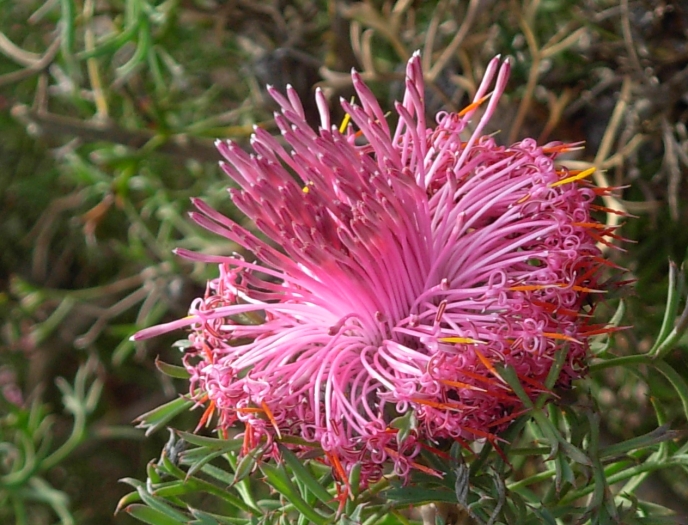Pincushion Coneflower
(Isopogon dubius)
Pincushion Coneflower (Isopogon dubius)
/
/

User:JarrahTree
CC BY 2.5 au
Image By:
User:JarrahTree
Recorded By:
Copyright:
CC BY 2.5 au
Copyright Notice:
Photo by: User:JarrahTree | License Type: CC BY 2.5 au | License URL: https://creativecommons.org/licenses/by/2.5/au/deed.en | Uploader: JarrahTree | Publisher: Wikimedia Commons | Title: Drummond_res-10.JPG | Notes: |




















Estimated Native Range
Summary
Isopogon dubius, commonly known as Pincushion Coneflower, is an evergreen shrub native to the sandy plains and open forests of Southwestern Australia. It typically grows to a height of 1-2 meters and a similar width, with a dense, rounded form. The plant is notable for its unique, spherical flower heads that resemble pincushions, which are composed of numerous small, tubular pink flowers blooming mainly in winter. The fruit is a distinctive hairy nut, which is fused with others to form a hemispherical head up to 30 mm (1.2 in) in diameter. These features make it an attractive choice for gardeners seeking year-round interest.
Pincushion Coneflower is valued for its drought tolerance and unique floral display. It is often used in xeriscaping, rock gardens, and native plant landscapes. The plant’s ability to withstand dry summers and moderate frosts makes it suitable for a variety of garden settings. It requires full sun to thrive and produce the best flower display, although it can tolerate partial shade. In cultivation, it does best with low water requirements and in well-draining soils. Gardeners should be aware that Isopogon dubius can be sensitive to root disturbance, so it is best to plant it in a permanent location where it will not need to be moved.CC BY-SA 4.0
Pincushion Coneflower is valued for its drought tolerance and unique floral display. It is often used in xeriscaping, rock gardens, and native plant landscapes. The plant’s ability to withstand dry summers and moderate frosts makes it suitable for a variety of garden settings. It requires full sun to thrive and produce the best flower display, although it can tolerate partial shade. In cultivation, it does best with low water requirements and in well-draining soils. Gardeners should be aware that Isopogon dubius can be sensitive to root disturbance, so it is best to plant it in a permanent location where it will not need to be moved.CC BY-SA 4.0
Plant Description
- Plant Type: Shrub
- Height: 1.5-5 feet
- Width: 1.5-5 feet
- Growth Rate: Moderate
- Flower Color: Pink
- Flowering Season: Winter
- Leaf Retention: Evergreen
Growth Requirements
- Sun: Full Sun
- Water: Low
- Drainage: Fast
Common Uses
Bee Garden, Bird Garden, Butterfly Garden, Low Maintenance, Showy Flowers
Natural Habitat
Sandy plains and open forests of Southwestern Australia
Other Names
Common Names: Pincushion-Coneflower, Rose-Coneflower
Scientific Names: , Isopogon dubius, Isopogon roseus, Atylus roseus, Isopogon scaber, Petrophila dubia, Petrophile dubia,
GBIF Accepted Name: Isopogon dubius (R.Br.) Druce